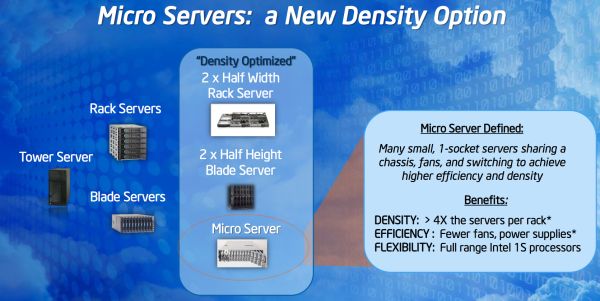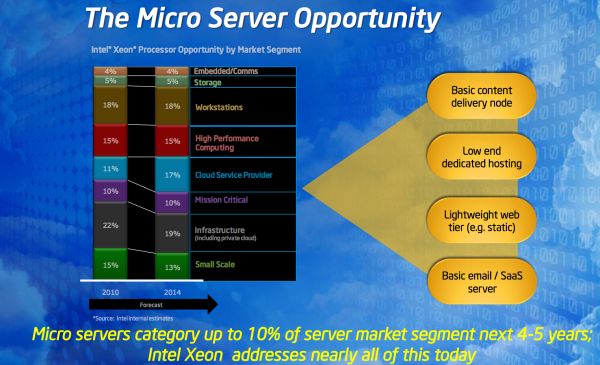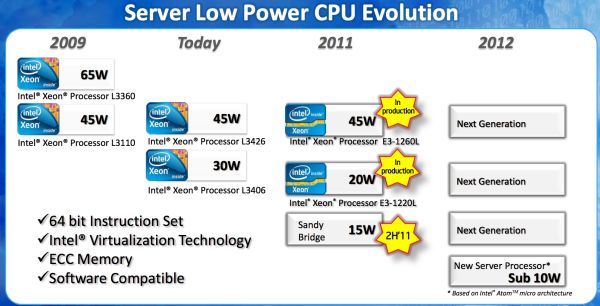Intel Plans on Bringing Atom to Servers in 2012, 20W SNB Xeons in 2011
by Anand Lal Shimpi on March 15, 2011 2:35 PM EST- Posted in
- IT Computing
- CPUs
- Intel
- Atom
- Xeon
The transition to smaller form factors hasn't been exclusively a client trend over the past several years, we've seen a similar move in servers. The motiviation is very different however. In the client space it's about portability, in the datacenter it's about density. While faster multi-core CPUs have allowed the two-socket 1U server to really take off, they have also paved the way for a new category of density optimized servers: the micro server.
The argument for micro servers is similar to that for ultra low power clients. Only a certain portion of workloads really require high-end multi-socket servers, the rest spend much of their time idle and thus are better addressed by lower power, higher density servers. Johan typically argues that rather than tackling the problem with micro servers it's a better idea to simply increase your consolidation ratio into fewer, larger servers. There are obviously proponents on both sides of the fence but Intel estimates that the total market for micro servers will reach about 10% of its total shipments over the next 4 - 5 years. It's a small enough market for Intel not to be super concerned about but large enough that it needs to be properly addressed.
Today Intel believes that it addresses this market relatively well with the existing Xeon lineup. Below is a table of Sandy Bridge Xeons including a 45W and 20W part, these two being directed primarily at the micro server market:
| Intel SNB Xeon Lineup | ||||||||
| Intel Xeon Processor Number | Cores / Threads | Clock Speed | Single Core Max Turbo | L3 Cache | Memory Support (Channels / DIMMs / Max Capacity) | Power (TDP) | ||
| E3-1280 | 4 / 8 | 3.50GHz | 3.90GHz | 8MB | 2 / 4 / 32GB | 95W | ||
| E3-1270 | 4 / 8 | 3.40GHz | 3.80GHz | 8MB | 2 / 4 / 32GB | 80W | ||
| E3-1260L | 4 / 8 | 2.40GHz | 3.30GHz | 8MB | 2 / 4 / 32GB | 45W | ||
| E3-1240 | 4 / 8 | 3.30GHz | 3.70GHz | 8MB | 2 / 4 / 32GB | 80W | ||
| E3-1230 | 4 / 8 | 3.20GHz | 3.60GHz | 8MB | 2 / 4 / 32GB | 80W | ||
| E3-1220L | 2 / 4 | 2.20GHz | 3.40GHz | 3MB | 2 / 4 / 32GB | 20W | ||
| E3-1220 | 4 / 4 | 3.10GHz | 3.40GHz | 8MB | 2 / 4 / 32GB | 80W | ||
Drop clock speed (and voltage) low enough and you can hit the lower TDPs necessary to fit into a micro server. Thermal constraints are present since you're often cramming a dozen of these servers into a very small area.
Long term there is a bigger strategy issue that has to be addressed. ARM has been talking about moving up the pyramid and eventually tackling the low end/low power server market with its architectures. While Xeon can scale down, it can't scale down to the single digit TDPs without serious performance consequences. Remember the old rule of thumb: a single microprocessor architecture can only address an order of magnitude of TDPs. Sandy Bridge can handle the 15 - 150W space, but get too much below 15W and it becomes a suboptimal choice for power/performance.
The solution? Introduce a server CPU based on Intel's Atom architecture. And this is the bigger part of the announcement today. Starting in 2012 Intel will have an Atom based low power server CPU with sub-10W TDPs designed for this market. Make no mistake, this move is designed to combat what ARM is planning. And unlike the ultra mobile space, Intel has an ISA advantage in the enterprise market. It'll be tougher for ARM to move up than it will be for Intel to move down.
Intel's slide above seems to imply that we'll have ECC support with this server version of Atom in 2012, which is something current Atom based servers lack.
The only real question that remains is what Atom architecture will be used? We'll see an updated 32nm Atom by the end of 2011 but that's still fundamentally using the same Bonnell core that was introduced back in 2008. Intel originally committed to keeping with its in-order architecture for 5 years back in 2008, that would mean that 2012 is ripe for the introduction of an out-of-order Atom. Whether or not that updated core will make it in time for use in Atom servers is still up for debate.













53 Comments
View All Comments
mino - Wednesday, March 16, 2011 - link
There are MANY, MANY use case where e dedicated physical machine is either required or good to have. This is where the real market is.Give me a physical hosting on Atom over Virtuozzo "hosting" any day.
mfeller2 - Tuesday, March 15, 2011 - link
1. I run an Atom "server" at home. File serving, proxy server, light web server duty, at a whopping 22 W typical. Smaller, quieter, and more power thrifty than the re-dedicated desktop.2. I have been interested in AMD's solution because (I believe) it supports VT in a slightly higher power envelope. Current Atom does not have hardware support for VMs. I sometimes use VM's as sand boxes to experiment in.
My use is not mainstream, and not the focus of Intel or this article, but adding ECC to the mix has an appeal to my little niche.
Taft12 - Wednesday, March 16, 2011 - link
If you're only using VMs as experimental sandboxes, who cares if you don't have hardware support for virtualization? It still works.mino - Wednesday, March 16, 2011 - link
And is painfully (borderline useless) slow on in-order Atom. :)madmilk - Saturday, March 3, 2012 - link
I run an Athlon II X2 250 in my server. Power consumption is about 29W idling with an extra Intel NIC and 4GB DDR3, as well as one 3.5" 5400rpm hard drive spinning at all times and 2 more spun down but still connected. It supports VT, and if I had the right motherboard (which I don't) it can also use ECC memory.Pretty nice, I think!
vol7ron - Tuesday, March 15, 2011 - link
Is this article in any relation to: http://www.anandtech.com/show/4208/cebit-2011-some...devene - Tuesday, March 15, 2011 - link
I think that they are being shortsighted. Instead of limiting the server why not make a hybrid server that uses both low power and medium power CPUs? The small cores take over during light loads while the heavy weights wait power gated in some low C state, and once load peaks, the serer kicks in with full force. The idea sounds like a logistics nightmare but if anyone has the resources to solve it, it's intel...DanNeely - Wednesday, March 16, 2011 - link
I believe high end VM farm software allows you to shuffle VM's between machines on demand; is there really a need to put both high and low end CPUs in the same enclosure instead of swapping the VM between two separate servers in the same rack?pjkenned - Tuesday, March 15, 2011 - link
ServeTheHome.com already has benchmarks of the Xeon E3-1220, E3-1230, and E3-1280 CPUs up, and has had them up for some time.JMC2000 - Wednesday, March 16, 2011 - link
Why did Intel change the Xeon model number scheme? There was some kind of continuity with the 3xxx, 5xxx and 7xxx lines.